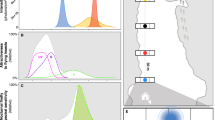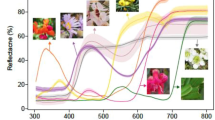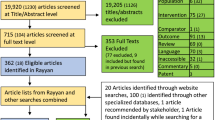Abstract
Artificial illumination attracts insects, but to what extent light attracts insects, depends on the spectral composition of the light. Response models have been developed to predict the attractiveness of artificial light sources. In this study we compared attraction of insects by existing light sources used for streetlights as well as newly developed environment friendly alternatives, and used this data to test the predictive ability of the existing response models. Light sources differed in overall attractiveness to insects and relative attractiveness was dependent on insect order. The attraction patterns predicted by the two models correlated weakly with the number of insects attracted when the only light source rich in UV, a mercury vapour light, was included in the tested spectra. When the mercury vapour light, which is going to be banned in Europe, was not included in the test no correlation was found between predicted and observed attraction patterns. We conclude that currently existing attraction response models are insufficiently sensitive to evaluate new light sources.


Similar content being viewed by others
References
Baker RR, Sadovy Y (1978) The distance and nature of the light-trap response of moths. Nature 276(5690):818–821
Barghini A, De Medeiros BAS (2012) UV radiation as an attractor for insects. LEUKOS J Illum Eng Soc 9(1):47–56. doi:10.1582/leukos.2012.09.01.003
Briscoe AD, Chittka L (2003) The evolution of color vision in insects. Annu Rev Entomol 46:471–510
Cinzano P, Falchi F, Elvidge CD (2001) The first world atlas of the artificial night sky brightness. Mon Not R Astron Soc 328(3):689–707. doi:10.1046/j.1365-8711.2001.04882.x
Cleve K (1964) Der Anflug der Schmetterlinge an künstliche lichtquellen. Mitt Dt Ent Ges 23:66–76
Conrad KF, Warren MS, Fox R, Parsons MS, Woiwod IP (2006) Rapid declines of common, widespread British moths provide evidence of an insect biodiversity crisis. Biol Conserv 132(3):279–291. doi:10.1016/j.biocon.2006.04.020
Dos Santos TG, De Mello Gaia MC, Peçanha Brazil R (2003) Attraction of sand flies (Diptera: Psychodidae) to light traps in rural areas of Minas Gerais State, Brazil. J Am Mosq Control Assoc 19(1):74–78
Eisenbeis G (2006) Artificial night lighting and insects: attraction of insects to streetlamps in a rural setting in Germany. Ecological consequences of artificial night lighting. Island press, Washington
Eisenbeis G, Eick K (2010) Attraction of nocturnal insects to street lights with special regard to LEDs. In: Abstracts of the Society for Conservation Biology, 24th Annual Meeting, Edmonton, Alberta
Eisenbeis G, Hassel F (2000) Zur Anziehung nachtaktiver Insekten durch Straßenlaternen—eine Studie kommunaler Beleuchtungseinrichtungen in der Agrarlandschaft Rheinhessens. Natur und Landschaft 75(4):145–156
EU (2009a) Commission Regulation (EC) No 244/2009 of 18 March 2009 implementing Directive 2005/32/EC of the European Parliament and of the Council with regard to ecodesign requirements for non-directional household lamps. Off J Eur Union 76:3–16
EU (2009b) Commission Regulation (EC) No 244/2009: implementing Directive 2005/32/EC of the European Parliament and of the Council with regard to ecodesign requirements for fluorescent lamps without integrated ballast, for high intensity discharge lamps, and for ballasts and luminaires able to operate such lamps, and repealing Directive 2000/55/EC of the European Parliament and of the Council. Off J Eur Union 76:17–44
EU (2010) Commission Regulation (EU) No 347/2010: amending Commision Regulation (EC) No 245/2009 as regards the ecodesign requirements for flourescent lamps without integrated ballast, for high intensity discharge lamps, and for ballasts and luminaries able to operate such lamps. Off J Eur Union 104:20–28
Fox R (2013) The decline of moths in Great Britain: a review of possible causes. Insect Conserv Divers 6(1):5–19. doi:10.1111/j.1752-4598.2012.00186.x
Fox R, Randle Z, Hill L, Anders S, Wiffen L, Parsons MS (2011) Moths count: recording moths for conservation in the UK. J Insect Conserv 15(1):55–68. doi:10.1007/s10841-010-9309-z
Garstang RH (2004) Mount Wilson observatory: the sad story of light pollution. Observatory 124(1178):14–21
Gaston KJ, Davies TW, Bennie J, Hopkins J (2012) Reducing the ecological consequences of night-time light pollution: options and developments. J Appl Ecol 49(6):1256–1266. doi:10.1111/j.1365-2664.2012.02212.x
Goretti E, Coletti A, Di Veroli A, Di Giulio AM, Gaino E (2011) Artificial light device for attracting pestiferous chironomids (Diptera): a case study at Lake Trasimeno (Central Italy). Ital J Zool 78(3):336–342. doi:10.1080/11250003.2010.534115
Groenendijk D, Ellis WN (2011) The state of the Dutch larger moth fauna. J Insect Conserv 15(1):95–101. doi:10.1007/s10841-010-9326-y
Hölker F, Wolter C, Perkin EK, Tockner K (2010) Light pollution as a biodiversity threat. Trends Ecol Evol 25(12):681–682. doi:10.1016/j.tree.2010.09.007
Hu KG, Stark WS (1977) Specific receptor input into spectral preference in Drosophila. J Comp Physiol A 121(2):241–252. doi:10.1007/bf00609614
Hu KG, Stark WS (1980) The roles of Drosophila ocelli and compound eyes in phototaxis. J Comp Physiol A 135(1):85–95. doi:10.1007/bf00660183
Ingpen A (1839) Instructions for collecting and preserving British and foreign insects: also for collecting and preserving Crustacea and Shells, 2nd edn. William Smith, London
Ishiwata K, Sasaki G, Ogawa J, Miyata T, Su ZH (2011) Phylogenetic relationships among insect orders based on three nuclear protein-coding gene sequences. Mol Phylogenetic Evol 58(2):169–180. doi:10.1016/j.ympev.2010.11.001
Longcore T, Rich C (2004) Ecological light pollution. Front Ecol Environ 2:191–198
Menzel R, Greggers U (1985) Natural phototaxis and its relationship to colour vision in honeybees. J Comp Physiol A 157:311–321
Menzel R, Ventura D, Hertel H (1986) Spectral sensitivity of photoreceptors in insect compound eyes: comparison of species and methods. J Comp Physiol A 158:165–177
Merckx T, Slade EM (2014) Macro-moth families differ in their attraction to light: implications for light-trap monitoring programmes. Insect Conserv Divers. doi:10.1111/icad.12068
Poot H, Ens BJ, de Vries H, Donners MAH, Wernand MR, Marquenie JM (2008) Green light for nocturnally migrating birds. Ecol Soc 13(2)
Rea M (ed) (1993) Lighting handbook: reference & application, 8th edn. Illuminating Engineering Society of North America, New York
Robinson HS, Robinson PJM (1950) Some notes on the observed behaviour of lepidoptera in the vicinity of light-sources together with a description of a light-trap designed to take entomological samples. Entomol Gaz 11:121–132
Somers-Yeates R, Hodgson D, McGregor PK, Spalding A, Ffrench-Constant RH (2013) Shedding light on moths: shorter wavelengths attract noctuids more than geometrids. Biol Lett 9(4):20130376. doi:10.1098/rsbl.2013.0376
Truxa C, Fiedler K (2012) Attraction to light-from how far do moths (Lepidoptera) return to weak artificial sources of light? Eur J Entomol 109(1):77–84
van Langevelde F, Ettema JA, Donners M, WallisDeVries MF, Groenendijk D (2011) Effect of spectral composition of artificial light on the attraction of moths. Biol Conserv 144(9):2274–2281. doi:10.1016/j.biocon.2011.06.004
Van Veen M, Zeegers T (1993) Insecten basisboek. Jeugdbondsuitgeverij, Utrecht
Waring P, Townsend M (2006) Nachtvlinders veldgids met alle in Nederland en België voorkomende soorten. Tirion Uitgevers, Baarn
Williams C (1936) The influence of moonlight on the activity of certain nocturnal insects, particularly of the family Noctuidae, as indicated by a light trap. Philos Trans R Soc Lond Ser B, Biol Sci 226:357–389
Acknowledgments
We thank G. Biewenga and J. Zonderland of Nij Bosma Zathe for their assistance. Dr. R. Kats and Drs. E. Drent are acknowledged for their helpful support. This project is funded by NWO-STW Grant 11110, Philips Lighting and the Dutch Oil Company (Nederlandse Aardolie Maatschappij).
Author information
Authors and Affiliations
Corresponding author
Electronic supplementary material
Below is the link to the electronic supplementary material.
Rights and permissions
About this article
Cite this article
van Grunsven, R.H.A., Donners, M., Boekee, K. et al. Spectral composition of light sources and insect phototaxis, with an evaluation of existing spectral response models. J Insect Conserv 18, 225–231 (2014). https://doi.org/10.1007/s10841-014-9633-9
Received:
Accepted:
Published:
Issue Date:
DOI: https://doi.org/10.1007/s10841-014-9633-9




